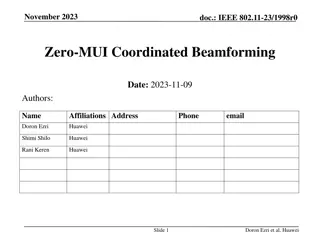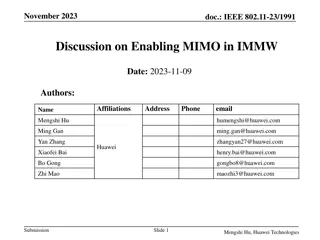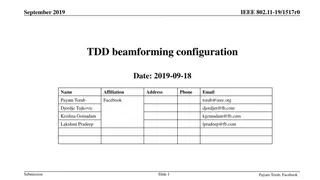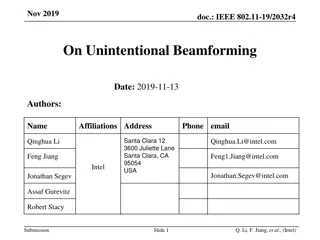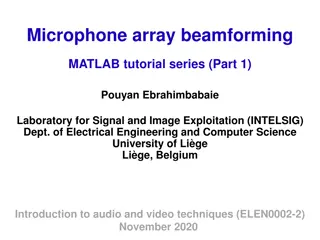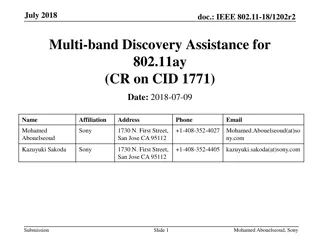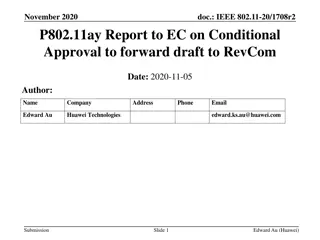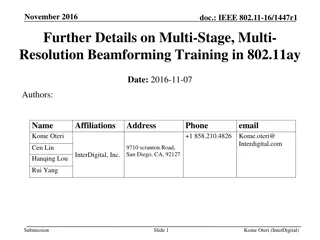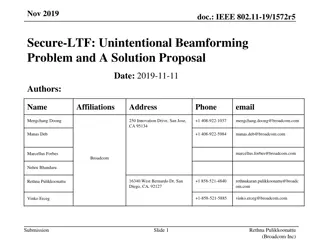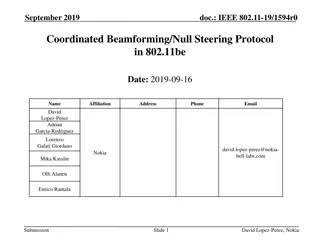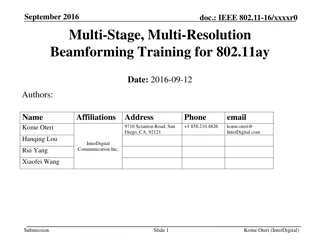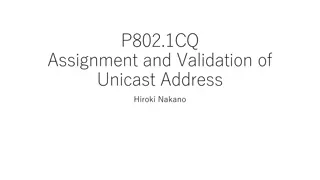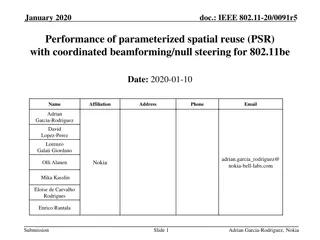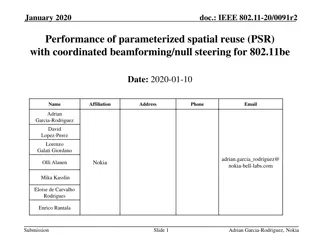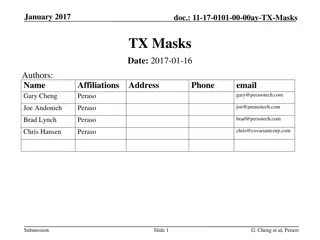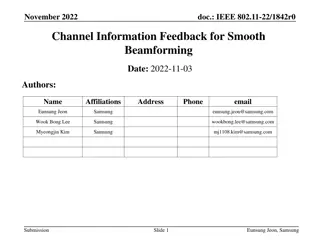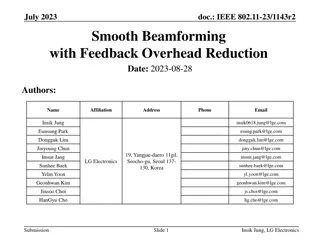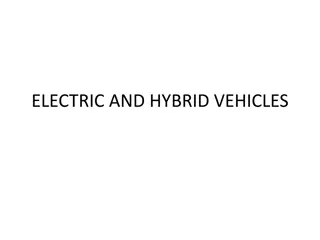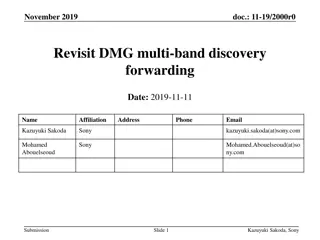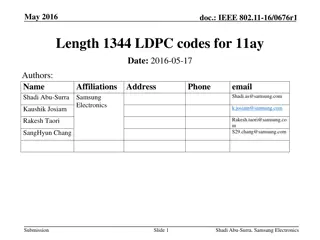
Hybrid Beamforming Protocols in IEEE 802.11ay Standard
Explore the implementation and benefits of hybrid beamforming in IEEE 802.11ay for SU and MU-MIMO scenarios. The protocols presented demonstrate the performance advantages over analog beamforming, highlighting the use of combined baseband and analog techniques. Various beamforming methods are compared to showcase efficiency improvements in transmission technology.
Download Presentation

Please find below an Image/Link to download the presentation.
The content on the website is provided AS IS for your information and personal use only. It may not be sold, licensed, or shared on other websites without obtaining consent from the author. If you encounter any issues during the download, it is possible that the publisher has removed the file from their server.
You are allowed to download the files provided on this website for personal or commercial use, subject to the condition that they are used lawfully. All files are the property of their respective owners.
The content on the website is provided AS IS for your information and personal use only. It may not be sold, licensed, or shared on other websites without obtaining consent from the author.
E N D
Presentation Transcript
March 2017 doc.: IEEE 802.11-17/0429r4 Protocols for Hybrid Beamforming in 802.11ay Date: 2017-03-12 Authors: Name Kome Oteri Affiliations Address Phone +1 858.210.4826 email Kome.oteri@ Interdigital.com 9710 Scranton Road, # 250 San Diego, CA, 92127 Li Hsiang Sun Alphan Sahin Hanqing Lou Rui Yang InterDigital, Inc. Submission Slide 1 Kome Oteri (InterDigital)
March 2017 doc.: IEEE 802.11-17/0429r4 Hybrid Beamforming in 802.11ay Hybrid beamforming has been proposed in 802.11ay to enable transmission of multiple streams for SU and MU-MIMO [1]. It combines baseband beamforming with analog beamforming to improve performance In this contribution, we show the performance gain of hybrid beamforming over analog beamforming with and without feedback in SU-MIMO Tx. Finally, we present protocols to enable hybrid beamforming in SU/MU-MIMO. Digital Controller PA 1 V1 DAC/Up convert er ... Coding/ Modulation VNt1 Nt antennas Digital precode r ... Coding/ Modulation V12 DAC/Up convert er ... PA 2 VNt Digital Controller U11 ADC/ Down convert er LNA U12 Decoding/ Demodulation Nr antennas ... Digital receiver ... ... Decoding/ Demodulation ADC/ Down convert er UNr1 LNA 2 UNr Analog Beamforming Architecture Hybrid Beamforming Architecture Submission Slide 2 Kome Oteri (InterDigital)
March 2017 doc.: IEEE 802.11-17/0429r4 Current Specification (D0.2) 10.38.9.2.1 General An EDMG STA may support hybrid precoding (defined as a combination of analog beamforming and digital baseband precoding) for SU-MIMO. An EDMG STA may support hybrid precoding (defined as a combination of analog beamforming and digital baseband precoding) for MU-MIMO. Editor Note: need to define the mechanisms to achieve the above. Submission Slide 3 Kome Oteri (InterDigital)
March 2017 doc.: IEEE 802.11-17/0429r4 Hybrid Beamforming ? = ? ?????? + ? ; ???= ? ?? H = channel; HBB = effective baseband channel FA = Analog beamformer; FBB = Baseband beamformer F = Ideal baseband precoder; FAFBB = Hybrid beamformer; FAFBB F Case 1: FA and FBB unknown Estimate H Design F for H Design FA / FBB from F Case 2: FA and FBB unknown Estimate H Design FA and calculate HBB Design FBB from HBB Submission Slide 4 Kome Oteri (InterDigital)
March 2017 doc.: IEEE 802.11-17/0429r4 Beamforming Performance in 802.11ay We will compare the relative performance of three beamforming methods in 802.11ay Analog Beamforming with Random Selection: Design analog beamformer Randomly select N of the M Antenna Weighting Vectors (AWVs) No channel knowledge needed at transmitter Analog Beamforming with Selection: Design analog beamformer Select the best N of the M AWVs Channel knowledge needed at transmitter Hybrid Beamforming with ideal feedback: Design analog beamformer Feed back M-dimensional effective digital baseband channel. Use SVD based on the time domain channel matrix of the strongest path to transmit N streams Submission Slide 5 Kome Oteri (InterDigital)
March 2017 doc.: IEEE 802.11-17/0429r4 Simulation Assumptions Based on 11ad/ay SC PHY [2] 2 spatial streams with spatial stream parser Vertical Encoding 25 meter 1.8 m MCS index is the same for all streams per PPDU, single CRC per PPDU (use MCS 14: /2 16QAM, rate ) [2] MMSE receiver Enterprise Cubicle (CB) scenario in 11ay/ad channel model [3] STAs located on the table at a height of 0.7m in the cubicle AP positioned in the middle below the ceiling at a height of 2.9 m Real channel estimation at receiver Detailed assumptions can be found in the appendix STA2 STA1 2.5 m STA3 Cubicle 8 Cubicle 7 1.0 m Cubicle 5 Cubicle 6 1.0 m AP in ceiling Cubicle 4 Cubicle 3 Cubicle 1 Cubicle 2 y 0 1.0 m x 0 25 meter Submission Slide 4 Kome Oteri (InterDigital)
March 2017 doc.: IEEE 802.11-17/0429r4 Simulated SU-MIMO Configurations We implement the following beamformers: Analog beamforming random selection Analog beamforming with selection Hybrid beamforming We simulate Configuration #4 of the SU-MIMO PAA configurations [3] 4x4 channel, 2 PAAs with dual polarization on each side Submission Slide 7 Kome Oteri (InterDigital)
March 2017 doc.: IEEE 802.11-17/0429r4 Numerical Results Hybrid beamforming shows gain over both types of analog beamforming Submission Slide 8 Kome Oteri (InterDigital)
March 2017 doc.: IEEE 802.11-17/0429r4 Protocols for Hybrid BF in 802.11ay To implement hybrid BF in 802.11ay, we need the following: Initiator and Responder to agree on hybrid BF support. Indicate that initiator can perform hybrid BF Indicate that responder can feed back detailed information for a given configuration needed to support hybrid BF Note that the actual use of the HB is transparent to the responder Explicit baseband channel feedback for baseband precoder design. However, explicit feedback to enable HB is required. Proposed protocol extends current procedures for SU- MIMO and MU-MIMO in D0.2 [4] Submission Slide 9 Kome Oteri (InterDigital)
March 2017 doc.: IEEE 802.11-17/0429r4 SU-MIMO Hybrid BF Protocol Exchange hybrid beamforming capabilities AP indicates support for hybrid BF STA indicates ability to feed back detailed channel information AP indicates need for detailed feedback during MIMO setup Option 1: Detailed channel feedback occurs during MIMO feedback for SU-MIMO (D0.2: the feedback type for the responder link (e.g., SINR or time domain channel response)). Option 2: Detailed feedback occurs after MIMO feedback: HBB feedback Submission Slide 10 Kome Oteri (InterDigital)
March 2017 doc.: IEEE 802.11-17/0429r4 MU-MIMO Hybrid BF Protocol Option 1: (No change between the BF setup and MU-MIMO selection): MU- MIMO FB Poll feeds back all channel details D0.2: The BF Feedback frame carries the list of received initiator s transmit DMG antennas/sectors, each with its corresponding responder s receive DMG antenna/sector and the associated quality indicated Indicate need for detailed feedback during setup Option 2: (No change between the BF setup and MU-MIMO selection): request for detailed feedback after MU-MIMO selection : Digital Baseband Tracking (see [5]) Option 3: MU-MIMO selection different from BF setup : Digital Baseband Tracking (see [5]) Submission Slide 11 Kome Oteri (InterDigital)
March 2017 doc.: IEEE 802.11-17/0429r4 References [1] K. Oteri et. al., Beam Tracking for 802.11ay , IEEE doc. 11-16/0040r2 [2] IEEE Std 802.11-2016, December 2016 [3] A. Maltsev, et al, Channel models for IEEE 802 11ay , IEEE doc. 11-15/1150r8 [4] IEEE P802.11ay /D0.2, January 2017 [5] K. Oteri et. al., Further Discussion on Beam Tracking for 802.11ay , IEEE doc. 11-17/0426r0 Submission Slide 12 Kome Oteri (InterDigital)
March 2017 doc.: IEEE 802.11-17/0429r4 Straw Poll 1 Do you agree to update the 802.11ay specification to reflect that the detailed BRP feedback that occurs during SU-MIMO feedback may be used to support hybrid beamforming for SU-MIMO ? In scenarios where the detailed feedback is not carried in the SU- MIMO feedback, the initator may request for the detailed feedback at a later time (e.g. by digital baseband tracking if the device supports that capability). Submission Slide 13 Kome Oteri (InterDigital)
March 2017 doc.: IEEE 802.11-17/0429r4 Straw Poll 2 Do you agree to update the 802.11ay specification to reflect that a detailed feedback option in the MU-MIMO feedback phase (fed back in addition to the associated quality specified in D0.2) may be used to support hybrid beamforming for MU-MIMO ? In scenarios where the detailed feedback is not carried in the MU- MIMO feedback, the initator may request for the detailed feedback at a later time (e.g. by digital baseband tracking if the device supports that capability). The channel feedback is TBD Submission Slide 14 Kome Oteri (InterDigital)

